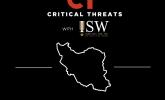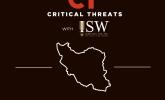Iran Crisis Update, November 17
November 17, 2022 - ISW PressCertain components of the ongoing protest movement in Iran may have reached the threshold identified in US military doctrine for a “latent and incipient” insurgency. American counter-insurgency doctrine, using a modified version of the Maoist insurgency framework, defines the lowest level of insurgency as follows:
“The first phase is latent and incipient. During this phase, activities include the emergence of insurgent leadership, creation of initial organizational infrastructure, training, acquisition of resources, and political actions, such as organizing protests. A group that eventually becomes members of an insurgency may simply be a legitimate political group at this stage. Governmental actions and changes in society can transform political groups into insurgencies.”
Components of the protest movement are approaching or have already achieved some of these requirements. The neighborhood youth groups and other protest organizations have seemingly continued playing significant roles in coordinating and planning demonstrations on specific days and in specific locations. These protest organizations are also encouraging and supporting citizens to attack and undermine the regime. The Mashhad Neighborhood Youth, for instance, published statements on November 16 and 17 calling on protesters to cooperate with one another to wage partisan warfare, block roads, and use explosives against security forces, among other activities, and referred to its “operational teams,” implying some level of organization. The group advised protesters to wear protective clothing “according to previous training.” The Mashhad youth group also stated that it is fighting a “full-scale war” against the regime—rhetoric that is consistent with the revolutionary tone used by other protest organizations in recent weeks.








